对外经贸大学:《商务英语写作》课程教学资源(授课教案)第二十四课 新闻稿 Press Releases
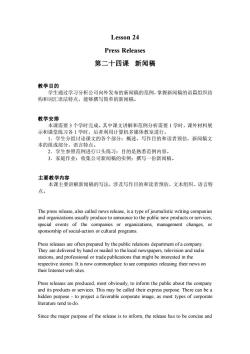
Lesson 24 Press Releases 第二十四课新闻稿 教学目的 学生通过学习分析公司向外发布的新闻稿的范例,掌握新闻稿的语篇组织结 构和词汇语法特点,能够撰写简单的新闻稿。 教学安排 本课需要3个学时完成。其中课文讲解和范例分析需要1学时,课外材料展 示和课堂练习各1学时,后者利用计算机多媒体教室进行。 1.学生分组讨论课文的各个部分:概述,写作目的和读者预估,新闻稿文 本的组成部分,语言特点。 2.学生参照范例进行口头练习:目的是熟悉范例内容。 3.家庭作业:收集公司新闻稿的实例;撰写一份新闻稿。 主要教学内容 本课主要讲解新闻稿的写法,涉及写作目的和读者预估、文本组织、语言特 点。 The press release,also called news release,is a type of journalistic writing companies and organizations usually produce to announce to the public new products or services, special events of the companies or organizations,management changes,or sponsorship of social-action or cultural programs. Press releases are often prepared by the public relations department of a company. They are delivered by hand or mailed to the local newspapers,television and radio stations,and professional or trade publications that might be interested in the respective stories.It is now commonplace to see companies releasing their news on their Internet web sites. Press releases are produced,most obviously,to inform the public about the company and its products or services.This may be called their express purpose.There can be a hidden purpose-to project a favorable corporate image,as most types of corporate literature tend to do. Since the major purpose of the release is to inform,the release has to be concise and
Lesson 24 Press Releases 第二十四课 新闻稿 教学目的 学生通过学习分析公司向外发布的新闻稿的范例,掌握新闻稿的语篇组织结 构和词汇语法特点,能够撰写简单的新闻稿。 教学安排 本课需要 3 个学时完成。其中课文讲解和范例分析需要 1 学时,课外材料展 示和课堂练习各 1 学时,后者利用计算机多媒体教室进行。 1.学生分组讨论课文的各个部分:概述,写作目的和读者预估,新闻稿文 本的组成部分,语言特点。 2.学生参照范例进行口头练习:目的是熟悉范例内容。 3.家庭作业:收集公司新闻稿的实例;撰写一份新闻稿。 主要教学内容 本课主要讲解新闻稿的写法,涉及写作目的和读者预估、文本组织、语言特 点。 The press release, also called news release, is a type of journalistic writing companies and organizations usually produce to announce to the public new products or services, special events of the companies or organizations, management changes, or sponsorship of social-action or cultural programs. Press releases are often prepared by the public relations department of a company. They are delivered by hand or mailed to the local newspapers, television and radio stations, and professional or trade publications that might be interested in the respective stories. It is now commonplace to see companies releasing their news on their Internet web sites. Press releases are produced, most obviously, to inform the public about the company and its products or services. This may be called their express purpose. There can be a hidden purpose - to project a favorable corporate image, as most types of corporate literature tend to do. Since the major purpose of the release is to inform, the release has to be concise and
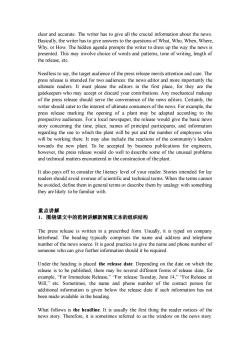
clear and accurate.The writer has to give all the crucial information about the news. Basically,the writer has to give answers to the questions of What,Who,When,Where, Why,or How.The hidden agenda prompts the writer to dress up the way the news is presented.This may involve choice of words and patterns,tone of writing,length of the release,etc. Needless to say,the target audience of the press release merits attention and care.The press release is intended for two audiences:the news editor and more importantly the ultimate readers.It must please the editors in the first place,for they are the gatekeepers who may accept or discard your contributions.Any mechanical makeup of the press release should serve the convenience of the news editors.Certainly,the writer should cater to the interest of ultimate consumers of the news.For example,the press release marking the opening of a plant may be adapted according to the prospective audiences.For a local newspaper,the release would give the basic news story concerning the time,place,names of principal participants,and information regarding the use to which the plant will be put and the number of employees who will be working there.It may also include the reactions of the community's leaders towards the new plant.To be accepted by business publications for engineers, however,the press release would do well to describe some of the unusual problems and technical matters encountered in the construction of the plant. It also pays off to consider the literacy level of your reader.Stories intended for lay readers should avoid overuse of scientific and technical terms.When the terms cannot be avoided,define them in general terms or describe them by analogy with something they are likely to be familiar with. 重点讲解 1.围绕课文中的范例讲解新闻稿文本的组织结构 The press release is written in a prescribed form.Usually,it is typed on company letterhead.The heading typically comprises the name and address and telephone number of the news source.It is good practice to give the name and phone number of someone who can give further information should it be required. Under the heading is placed the release date.Depending on the date on which the release is to be published,there may be several different forms of release date,for example,"For Immediate Release,""For release Tuesday,June 14,""For Release at Will,"etc.Sometimes,the name and phone number of the contact person for additional information is given below the release date if such information has not been made available in the heading. What follows is the headline.It is usually the first thing the reader notices of the news story.Therefore,it is sometimes referred to as the window on the news story
clear and accurate. The writer has to give all the crucial information about the news. Basically, the writer has to give answers to the questions of What, Who, When, Where, Why, or How. The hidden agenda prompts the writer to dress up the way the news is presented. This may involve choice of words and patterns, tone of writing, length of the release, etc. Needless to say, the target audience of the press release merits attention and care. The press release is intended for two audiences: the news editor and more importantly the ultimate readers. It must please the editors in the first place, for they are the gatekeepers who may accept or discard your contributions. Any mechanical makeup of the press release should serve the convenience of the news editors. Certainly, the writer should cater to the interest of ultimate consumers of the news. For example, the press release marking the opening of a plant may be adapted according to the prospective audiences. For a local newspaper, the release would give the basic news story concerning the time, place, names of principal participants, and information regarding the use to which the plant will be put and the number of employees who will be working there. It may also include the reactions of the community’s leaders towards the new plant. To be accepted by business publications for engineers, however, the press release would do well to describe some of the unusual problems and technical matters encountered in the construction of the plant. It also pays off to consider the literacy level of your reader. Stories intended for lay readers should avoid overuse of scientific and technical terms. When the terms cannot be avoided, define them in general terms or describe them by analogy with something they are likely to be familiar with. 重点讲解 1.围绕课文中的范例讲解新闻稿文本的组织结构 The press release is written in a prescribed form. Usually, it is typed on company letterhead. The heading typically comprises the name and address and telephone number of the news source. It is good practice to give the name and phone number of someone who can give further information should it be required. Under the heading is placed the release date. Depending on the date on which the release is to be published, there may be several different forms of release date, for example, “For Immediate Release,” “For release Tuesday, June 14,” “For Release at Will,” etc. Sometimes, the name and phone number of the contact person for additional information is given below the release date if such information has not been made available in the heading. What follows is the headline. It is usually the first thing the reader notices of the news story. Therefore, it is sometimes referred to as the window on the news story
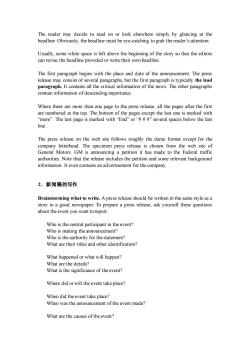
The reader may decide to read on or look elsewhere simply by glancing at the headline.Obviously,the headline must be eye-catching to grab the reader's attention. Usually,some white space is left above the beginning of the story so that the editors can revise the headline provided or write their own headline. The first paragraph begins with the place and date of the announcement.The press release may consist of several paragraphs,but the first paragraph is typically the lead paragraph.It contains all the critical information of the news.The other paragraphs contain information of descending importance. Where there are more than one page to the press release,all the pages after the first are numbered at the top.The bottom of the pages except the last one is marked with “more”,The last page is marked with"End”or“###'several spaces below the last line. The press release on the web site follows roughly the dame format except for the company letterhead.The specimen press release is chosen from the web site of General Motors.GM is announcing a petition it has made to the Federal traffic authorities.Note that the release includes the petition and some relevant background information.It even contains an advertisement for the company. 2.新闻稿的写作 Brainstorming what to write.A press release should be written in the same style as a story in a good newspaper.To prepare a press release,ask yourself these questions about the event you want to report: Who is the central participant in the event? Who is making the announcement? Who is the authority for the statement? What are their titles and other identification? What happened or what will happen? What are the details? What is the significance of the event? Where did or will the event take place? When did the event take place? When was the announcement of the event made? What are the causes of the event?
The reader may decide to read on or look elsewhere simply by glancing at the headline. Obviously, the headline must be eye-catching to grab the reader’s attention. Usually, some white space is left above the beginning of the story so that the editors can revise the headline provided or write their own headline. The first paragraph begins with the place and date of the announcement. The press release may consist of several paragraphs, but the first paragraph is typically the lead paragraph. It contains all the critical information of the news. The other paragraphs contain information of descending importance. Where there are more than one page to the press release, all the pages after the first are numbered at the top. The bottom of the pages except the last one is marked with “more”. The last page is marked with “End” or “# # #” several spaces below the last line. The press release on the web site follows roughly the dame format except for the company letterhead. The specimen press release is chosen from the web site of General Motors. GM is announcing a petition it has made to the Federal traffic authorities. Note that the release includes the petition and some relevant background information. It even contains an advertisement for the company. 2.新闻稿的写作 Brainstorming what to write. A press release should be written in the same style as a story in a good newspaper. To prepare a press release, ask yourself these questions about the event you want to report: Who is the central participant in the event? Who is making the announcement? Who is the authority for the statement? What are their titles and other identification? What happened or what will happen? What are the details? What is the significance of the event? Where did or will the event take place? When did the event take place? When was the announcement of the event made? What are the causes of the event?
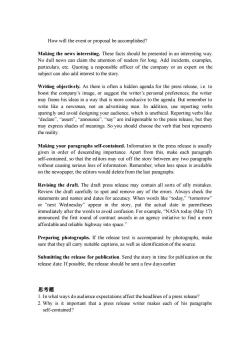
How will the event or proposal be accomplished? Making the news interesting.These facts should be presented in an interesting way. No dull news can claim the attention of readers for long.Add incidents,examples, particulars,etc.Quoting a responsible officer of the company or an expert on the subject can also add interest to the story. Writing objectively.As there is often a hidden agenda for the press release,i.e.to boost the company's image,or suggest the writer's personal preferences,the writer may frame his ideas in a way that is more conducive to the agenda.But remember to write like a newsman,not an advertising man.In addition,use reporting verbs sparingly and avoid designing your audience,which is unethical.Reporting verbs like “declare'”,assert',“announce”,“say”are indispensable to the press release,but they may express shades of meanings.So you should choose the verb that best represents the reality. Making your paragraphs self-contained.Information in the press release is usually given in order of descending importance.Apart from this,make each paragraph self-contained,so that the editors may cut off the story between any two paragraphs without causing serious loss of information.Remember,when less space is available on the newspaper,the editors would delete from the last paragraphs. Revising the draft.The draft press release may contain all sorts of silly mistakes. Review the draft carefully to spot and remove any of the errors.Always check the statements and names and dates for accuracy.When words like "today,""tomorrow" or "next Wednesday"appear in the story,put the actual date in parentheses immediately after the words to avoid confusion.For example,"NASA today (May 17) announced the first round of contract awards in an agency initiative to find a more affordable and reliable highway into space." Preparing photographs.If the release text is accompanied by photographs,make sure that they all carry suitable captions,as well as identification of the source. Submitting the release for publication.Send the story in time for publication on the release date.If possible,the release should be sent a few days earlier. 思考题 1.In what ways do audience expectations affect the headlines of a press release? 2.Why is it important that a press release writer makes each of his paragraphs self-contained?
How will the event or proposal be accomplished? Making the news interesting. These facts should be presented in an interesting way. No dull news can claim the attention of readers for long. Add incidents, examples, particulars, etc. Quoting a responsible officer of the company or an expert on the subject can also add interest to the story. Writing objectively. As there is often a hidden agenda for the press release, i.e. to boost the company’s image, or suggest the writer’s personal preferences, the writer may frame his ideas in a way that is more conducive to the agenda. But remember to write like a newsman, not an advertising man. In addition, use reporting verbs sparingly and avoid designing your audience, which is unethical. Reporting verbs like “declare”, “assert”, “announce”, “say” are indispensable to the press release, but they may express shades of meanings. So you should choose the verb that best represents the reality. Making your paragraphs self-contained. Information in the press release is usually given in order of descending importance. Apart from this, make each paragraph self-contained, so that the editors may cut off the story between any two paragraphs without causing serious loss of information. Remember, when less space is available on the newspaper, the editors would delete from the last paragraphs. Revising the draft. The draft press release may contain all sorts of silly mistakes. Review the draft carefully to spot and remove any of the errors. Always check the statements and names and dates for accuracy. When words like “today,” “tomorrow” or “next Wednesday” appear in the story, put the actual date in parentheses immediately after the words to avoid confusion. For example, “NASA today (May 17) announced the first round of contract awards in an agency initiative to find a more affordable and reliable highway into space.” Preparing photographs. If the release text is accompanied by photographs, make sure that they all carry suitable captions, as well as identification of the source. Submitting the release for publication. Send the story in time for publication on the release date. If possible, the release should be sent a few days earlier. 思考题 1. In what ways do audience expectations affect the headlines of a press release? 2. Why is it important that a press release writer makes each of his paragraphs self-contained?
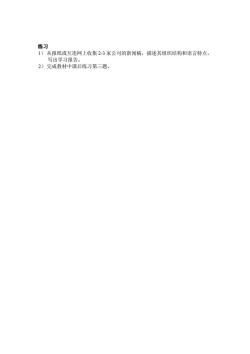
练习 1)从报纸或互连网上收集2-3家公司的新闻稿,描述其组织结构和语言特点, 写出学习报告。 2)完成教材中课后练习第三题
练习 1) 从报纸或互连网上收集 2-3 家公司的新闻稿,描述其组织结构和语言特点, 写出学习报告。 2)完成教材中课后练习第三题
按次数下载不扣除下载券;
注册用户24小时内重复下载只扣除一次;
顺序:VIP每日次数-->可用次数-->下载券;
- 对外经贸大学:《商务英语写作》课程教学资源(授课教案)第二十三课 感谢信和慰问信 Letters of Thanks & of Sympathy.doc
- 对外经贸大学:《商务英语写作》课程教学资源(授课教案)第二十二课 祝贺信 Congratulation Letters.doc
- 对外经贸大学:《商务英语写作》课程教学资源(授课教案)第二十一课 致辞祝词 Ceremonial Speeches.doc
- 对外经贸大学:《商务英语写作》课程教学资源(授课教案)第八课 对日常询函的中性答复 Neutral Replies to Routine Requests.doc
- 对外经贸大学:《商务英语写作》课程教学资源(授课教案)第七课 日常索赔和投诉信 Letters about Routine Claims and Complains.doc
- 对外经贸大学:《商务英语写作》课程教学资源(授课教案)第六课 日常订货信 Letters about Routine Orders.doc
- 对外经贸大学:《商务英语写作》课程教学资源(授课教案)第八课 对日常询函的中性答复 Neutral Replies to Routine Requests.doc
- 对外经贸大学:《商务英语写作》课程教学资源(授课教案)第七课 日常索赔和投诉信 Letters about Routine Claims and Complains.doc
- 对外经贸大学:《商务英语写作》课程教学资源(授课教案)第六课 日常订货信 Letters about Routine Orders.doc
- 对外经贸大学:《商务英语写作》课程教学资源(授课教案)第五课 日常询盘信 Letters about Routine Inquiries.doc
- 对外经贸大学:《世界贸易组织概论》课程教学资源(PPT授课教案)第十七讲 世贸组织贸易争端案例综述.ppt
- 对外经贸大学:《世界贸易组织概论》课程教学资源(PPT授课教案)第十六讲 入世与中国服务业发展.ppt
- 对外经贸大学:《世界贸易组织概论》课程教学资源(PPT授课教案)第十五讲 入世承诺与中国制造业发展.ppt
- 对外经贸大学:《世界贸易组织概论》课程教学资源(PPT授课教案)第十四讲 入世承诺与中国农业发展.ppt
- 对外经贸大学:《世界贸易组织概论》课程教学资源(PPT授课教案)第十三讲 入世承诺与中国宏观经济.ppt
- 对外经贸大学:《世界贸易组织概论》课程教学资源(PPT授课教案)第十二讲 中国与世贸组织的关系.ppt
- 对外经贸大学:《世界贸易组织概论》课程教学资源(PPT授课教案)第十一讲 多哈回合与发展中国家.ppt
- 对外经贸大学:《世界贸易组织概论》课程教学资源(PPT授课教案)第九讲 规范服务贸易的规则——《服务贸易总协定》.ppt
- 对外经贸大学:《世界贸易组织概论》课程教学资源(PPT授课教案)第十讲 规范知识产权保护的规则——《知识产权协定》.ppt
- 对外经贸大学:《世界贸易组织概论》课程教学资源(PPT授课教案)第八讲 与贸易有关的投资措施协议.ppt
- 对外经贸大学:《商务英语写作》课程教学资源(授课教案)第二十五课 产品使用说明 Operating Instructions.doc
- 对外经贸大学:《商务英语写作》课程教学资源(授课教案)第二十六课 商品描述 Technical Descriptions.doc
- 对外经贸大学:《商务英语写作》课程教学资源(授课教案)第二十七课 调查问卷 Questionnaires.doc
- 对外经贸大学:《微观经济学》课程教学资源(教学大纲,共十二章).pdf
- 对外经贸大学:《微观经济学》课程教学资源(教学日历).pdf
- 对外经贸大学:《微观经济学》课程教学资源(各章习题)第一章 引论.pdf
- 对外经贸大学:《微观经济学》课程教学资源(各章习题)第二章 需求和供给曲线概述以及有关的基本概念.pdf
- 对外经贸大学:《微观经济学》课程教学资源(各章习题)第三章 效用论.pdf
- 对外经贸大学:《微观经济学》课程教学资源(各章习题)第四章 生产论.pdf
- 对外经贸大学:《微观经济学》课程教学资源(各章习题)第五章 成本论.pdf
- 对外经贸大学:《微观经济学》课程教学资源(各章习题)第六章 完全竞争市场.pdf
- 对外经贸大学:《微观经济学》课程教学资源(各章习题)第七章 不完全竞争市场.pdf
- 对外经贸大学:《微观经济学》课程教学资源(各章习题)第八章 生产要素价格决定的需求方面.pdf
- 对外经贸大学:《微观经济学》课程教学资源(各章习题)第九章 生产要素价格决定的供给方面.pdf
- 对外经贸大学:《微观经济学》课程教学资源(各章习题)第十章 一般均衡论.pdf
- 对外经贸大学:《微观经济学》课程教学资源(各章习题)第十一章 福利经济学.pdf
- 对外经贸大学:《微观经济学》课程教学资源(各章习题)第十二章 市场失灵和微观经济政策.pdf
- 对外经贸大学:《微观经济学》课程教学资源(授课教案)第一节课 引论(现代西方经济学的由来和演变).pdf
- 对外经贸大学:《微观经济学》课程教学资源(授课教案)第二节课 供求曲线概述以及有关的基本概念(微观经济学的特点、需求曲线).pdf
- 对外经贸大学:《微观经济学》课程教学资源(授课教案)第三节课 供求曲线概述以及有关的基本概念(供给曲线).pdf
